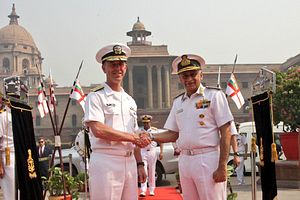Admiral John Richardson, the U.S. chief of naval operations, began a three-day visit to India this week. After arriving on Sunday, Richardson attended meetings on Monday with his Indian counterpart Admiral Sunil Lanba, the Indian Navy chief, as well as other senior officials.
Apart from Lanba, Richardson met with Indian Defense Secretary Sanjay Mitra, Vice Chief of Army Staff Lieutenant General Devraj Anbu, and the Indian Air Force’s Air Chief Marshal Birender Singh Dhanoa.
“Major issues discussed during the visit included operations and exercises, training interactions, information exchange, capacity building and capability enhancement,” a statement from the Indian Navy describing Richardson’s visit said.
Richardson’s visit to India comes shortly after the Indian Navy for the first time joined the U.S. Navy, the Japan Maritime Self-Defense Force, and the Philippine Navy for a sail-through of the South China Sea.
Given shared concerns about China, India and the United States have continued their strategic convergence over the last two years. Ahead of Richardson’s trip to India, U.S. Secretary of State Mike Pompeo reiterated that the United States was seeking partnerships with like-minded countries in the Indo-Pacific region.
The United States was “banding together with the like-minded nations like Australia, India, Japan and South Korea to make sure that each Indo-Pacific nation can protect its sovereignty from coercion,” Pompeo said, speaking in California.
The defense relationship between New Delhi and Washington has continued on a positive trajectory since the two sides signed a framework agreement in 2005. In 2012, the U.S. Department of Defense constituted the Defense Technology and Trade Initiative, which paved the way for closer U.S.-India exchange and cooperation on technology and co-development.
The two sides have also conducted multiple naval and other military exercises over the years. The bilateral U.S.-India Malabar naval exercise was trilateralized in 2015 to include Japan, a U.S. treaty ally and an Indian strategic partner.
In 2016, the Obama administration declared India a “major defense partner,” a bespoke status for New Delhi comparable to that of a major non-NATO ally as far as defense commercial access is concerned. The two sides also have concluded major foundational agreements, including the 2016 Logistics Exchange Memorandum of Agreement, an India-specific variant of the Acquisition and Cross-Servicing Agreements the United States has with a range of other countries, and the 2018 Communications Compatibility and Security Agreement.
“I am looking forward to this trip,” Richardson had said in a statement released before his arrival in India. “The strategic environment is becoming more complex and the nature of our shared challenges requires frequent discussion of our views of the maritime domain and how best our two navies can operate in line with our respective objectives.”

































